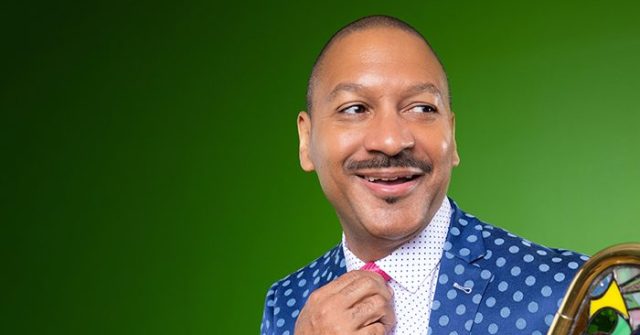
On March 1st, Glenn Miller’s birthday, another celebrated trombonist, Delfeayo Marsalis led his Uptown Jazz Orchestra into the Dakota for two spirited shows. Once the band was announced, it took a while for fourteen musicians (the fifteenth member, vocalist Tonya Boyd-Cannon, took the stage later), most of them from New Orleans, to find their spots and get settled. Once they did, Marsalis took us on a ride from Downtown Minneapolis to Uptown New Orleans!
The “Big Band” (or in this case, “Jazz Orchestra”) is an orchestrational anomaly. Generally speaking, it contains three sections of five saxophones, four trombones, and four trumpets, with a rhythm section (piano, guitar, bass, drums). It is too small to be considered a European-style orchestra, too focused to be an American-style marching band, too robust and bombastic for small-group jazz. It is its own thing, baked into the jazz language, with a tradition and canon that goes back as far as jazz itself. But as Delfeayo showed us, there is plenty of room for innovation within the tradition.
Delfeayo grew up in New Orleans, and it is this flavor that informs his Orchestra. While they faithfully replicate the classic sounds of the Basie and Ellington teams of the past, this nimble ensemble is also capable of serious funk grooves typically played by New Orleans street bands. We are taken from the Sands Hotel to Frenchmen Street in a matter of moments.
Marsalis started the second show exactly the way a big band show should start: with a brass band tune! The group handled “Let Your Mind Be Free”, the Soul Rebels classic, convincingly; it certainly helps to have so many brass band veterans in the band. Immediately Delfeayo drew the parallels between brass band and big band work: he would start a riff, a repeated pattern, from the middle of the ensemble. The single seed would spread as each horn player caught it and harmonized it, and in no time the whole group was playing the one idea. This is the Kansas City riff style, the way Jay McShann and Count Basie’s bands would come up with their “arrangements” (long before anyone thought to write them out). And it’s exactly the type of riffing one hears from brass bands on the streets and in the clubs of New Orleans.
The economics of a touring big band is not pretty. Travel expenses have spelled the end of all but a precious few, the best of the best, and even they just barely got by. Delfeayo mitigates these realities in a couple of ways: Minneapolis saxophone hero Chris Thomson admirably held down one of the tenor saxophone chairs. The brass all fit in one long line because there were only two trombones, which led even more to the brass band feel. Two trombones are usually not enough for a big band unless those trombonists happen to be Delfeayo and T.J. Norris! They more than held down the low end of the band, aided by baritone saxophonist Shaena Ryan.
It’s not easy to sing with a big band: it takes a certain type of voice to sail over all those horns, and a bold, confident personality. Tonya Boyd-Cannon is exactly that type of vocalist. Her range, in terms of notes and also material, is enormous. She strutted through Galactic-style funk tunes, displayed her classical chops on a stunning “Summertime” that evoked the original (it started as an aria from Gershwin’s opera Porgy and Bess), channeled Dinah Washington on a sultry “What a Difference a Day Makes”. At one point in one of the funk tunes, mid-vocal, she glanced behind her and shook her hand sideways, the universal sign for “hand a girl a tambourine!” Delfeayo dutifully complied. Here’s hoping we see her back at the Dakota with her own show soon!
It’s important to acknowledge the wall-shaking power of the trombone, often the loudest acoustic instrument in any band. Marsalis, long admired for his creative restraint, often chose to play quietly. He played a stirring “There Is No Greater Love” with just the rhythm section backing him up, a brilliant bit of contrast to a notable show for its high points (nod to the ridiculous lead trumpet playing!).
While the first show featured a lot of jazz, the second was funky. They played several selections from the Orchestra’s new album, Uptown on Mardi Gras Day, including several vocal features from the trumpet section (and of course Ms. Boyd-Cannon). They rounded out the evening the only way they could, with a lengthy, loping version of “Lil’ Liza Jane”, replete with the singalong chorus.
It is unnecessary at this stage in their careers to mention Delfeayo’s brothers, jazz stars in their own right. But it’s perhaps illustrative to consider Wynton, trumpet hero and leader of the Lincoln Center Jazz Orchestra. For decades the LCJO has been the pinnacle of big band performance: clean and precise arrangements, spirited improvisation, but often lacking that verve, the fire that makes New Orleans music so exciting. It is “high-brow jazz”, with Wynton leading from the back row, setting the vibe for each performance. It was fun to see Delfeayo in the same spot on stage, not in a black suit but in a loud green Mardi Gras-style suit, setting a very different vibe, by no means “low-brow”, just one a little closer to their roots.

